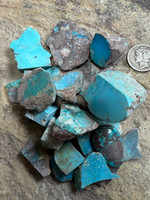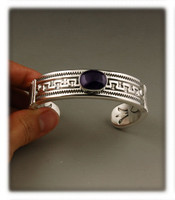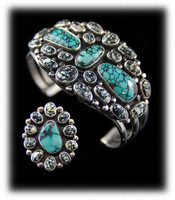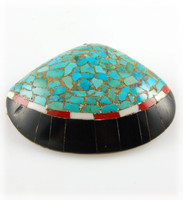 Loading... Please wait...
Loading... Please wait...- 970-759-1040 Text / Voice
- Gift Certificates
- My Account
Currency Displayed in
Categories
Frequently Asked Questions
Frequently Asked Questions
Turquoise and Silver Frequently Asked Questions
Do you have a printed catalog?
No. Our website is our catalog. Since most of our turquoise jewelry is one of a kind and is our inventory is ever changing we do not have a printed catalog.
Do you have a layaway plan?
Yes, we do accept layaway plans. We like to have 1/3 down payment at the time of purchase and paid in three months. If the you are purchasing an item larger than $1,000.00 USD and would like to extend payments out to 6 months (maximum) please let us know. WE DO NOT EXCEPT LAYAWAYS OF OVER 6 MONTHS. Once you have engaged in a lay-a-way, you are in a contract with us to purchase the exact item that you have put on lay-a-way. This means we are taking it out of the view of other potential buyers and will not have a chance to sell it. For this reason WE DO NOT GIVE REFUNDS ON UNFINISHED LAYAWAY PLANS. You are also committed to the exact item that you put on layaway, we will not trade merchandise during the lay-a-way, unless you are will to pay a $20.00 service charge.
When making payments you may call in your layaway order or email us that you are sending in payment and we will remove this item so that it does not sell in the meantime. You are also welcome to choose the Money Order option at checkout and proceed to checkout as normal. In the notes please state that you would like to put the item on either a 3 or 6 month layaway plan. Please state how you would like to pay and we will contact you shortly to arrange payment and set up the plan.
You may also click the PayPal option and once you sign into PayPal you can set up a layaway plan THROUGH PAYPAL . it will automatically remove the item and purchase it from us with payment in full. You will make your payments through PayPal to PayPal for the duration of your layaway. We will not be responsible for your payments to PayPal, nor will we have anything to do with it. This will seem like a standard payment to us.
Any questions, just email dillon@durangosilver.com or call 970-375-2401!
What is your guarantee and return policy?
We can provide a Certificate of Authenticity upon request for items of significant value. Your purchase is 100 % Satisfaction Guaranteed. If someone needs to return something we ask that it is returned within 10 days of receipt and in original condition. You will receive a 100 % refund of the price of the item minus a 5% restocking fee to cover our costs.
How do you ship?
OUR PREFERRED AND STANDARD SHIPPING SERVICE IS USPS PRIORITY MAIL. We ship via U.S. Priority Mail or UPS with insurance in the continental. U.S. We now offer Fed Ex over night. FedEx overnight with a Saturday delivery is available for an additional charge. Alaska - $10.95
What types of payment do you take?
We take Visa, Mastercard, American Express, Discover, Paypal, checks, Western Union, Bank Transfers, and money orders.
Do you size rings?
Ring sizing is usually $25.00 - $35.00. If the charge for sizing comes out less than quoted we will refund the difference back to you. Some rings we can size up 1/2 to a full size, depending on the ring, using a jeweler's ring roller free of charge. Note that some rings due to how they are made cannot be sized such as inlay. The easiest way and most accurate way to determine your ring size is to go to your local jeweler and either have your finger sized or take a ring that fits well and have it measured. Keep in mind wider band widths fit a bit smaller. We do not size rings that are not ours. Once we alter merchandise it is not eligible for a refund.
Do you convert earrings to clip on?
All earrings are pieced unless otherwise noted in the description. We can convert easily any earring on a French wire or ball post to a clip-on earring. The cost of the sterling silver converter is $3.00. If the earring is a post earring that you wish to convert, please e-mail us on the possibility of converting it to a clip-on earring. This will depend on the post earring and how it was made.
Shop for Earrings
How do I determine my bracelet size?
The easiest way is to measure your wrist with a tape measure or use a string and then measure the string with a ruler. Add the inside measurement of the bracelet to the opening measurement for total circumference. Bracelets that are adjustable are easiest to fit for size and comfort.
Shop for a Bracelet
Do you repair Sterling Silver & Indian jewelry?
We offer a 6 month workmanship warranty free of charge - no cost to customer. Items that have been damaged or broken will only be charged actual repair costs from the silversmith and shipping. We only repair items purchased from us. For other items please contact Dillon Hartman of Durango, CO at durangodillon@gmail.com or leave a voice mail at 970-799-2271.
Do you appraise jewelry?
You may contact John Hartman for appraisals. Please take a look at our Turquoise Value page for more info. We do charge for this service.
Follow this link for a Jewelry Appraisal.
John Hartman
17897 Hwy 160
Durango, CO 81301
If you are interested in selling an item the appraisal may be free of charge, please state your intent upon contacting us. DO NOT CALL OR EMAIL US ABOUT AN APPRAISAL IF YOU ARE NOT TRYING TO SELL THE ITEM TO US. We are overwhelmed with individuals who need appraisals and who are wanting to sell us jewelry. There is a charge for appraisals if the appraisal is for your personal knowledge.
Do you do custom work?
Not typically. If you are interested in a piece of jewelry we have but would like one made in a different size or stone this may be possible depending on who and how busy the silversmith is. We will accept customer orders on jewelry over $1500.00 USD.
How do I care for jewelry?
We highly recommend cleaning your Native American jewelry and silver jewelry with a polishing cloth and storing your jewelry in a jeweler’s zip lock bag to prevent tarnish. Soft clothes and tissue may also be used. Your stones should be kept away from harsh chemicals, cleaning detergents and heat. Some stones can be permanently damaged if cleaned in an ultrasonic cleaner: amber, coral, turquoise, lapis, opal, pearl. We have found the best cleaner that is safe for your gemstones to be Hagerty Silversmith’s Spray Polish.
Stones should be occasionally checked. If the stones are loose and wiggle, some simple repairs can be made by the owner. By placing a tiny amount of glue, such as Sobo – polyvinyl acetate emulsion, between the edges of a loosened stone and its bezel will help secure the stone. The edges of the bezel can be gently pressed in around the loosened stone, also, to help tighten the setting. If your stone comes completely out, the stone needs to be reset by an experienced jeweler or silversmith. Avoid excess bending of bracelets and most inlay bracelets can not be stretched or bent. With proper care, you should have a lifetime of enjoyment.
Do you use synthetic Turquoise?
NO, we do not and never will. We do however use stabilized turquoise on occasion as we have customer ask for it due to the durability. If we use stabilized turquoise we will state that in the product description.
Do you use any other Turquoise than American Turquoise?
Yes. We prefer and almost always use Natural American Turquoise, predominately Natural Nevada Turquoise in our jewelry. We do however, love all turquoise. When we find beautiful turquoise from other parts of the world we will give them a try and if the sell well we will continue to offer this turquoise in our jewelry. No matter what turquoise we use it will be clear listed in the product description. WE WILL NEVER MISREPRESENT OUR TURQUOISE AS WE ARE AMERICAN TURQUOISE MINERS OURSELVES, AS WELL AS HONEST AND ETHICAL JEWELERS. Please remember a rock is a rock, no mater where it comes from. :-)
Do you create jewelry with other gemstones than turquoise?
YES. We love almost all stones. Infact, Dillon is so obsessed that if he had his choice he would probably use them all if he had the time. We use Sugilite, Coral, Variscite, Turquoise, Black Onyx, Spiny Oyster Shell, Malachite, Azurite, Dinosaur Bone, Gaspeite, Charoite, Jade, Ruby, High-grade Gold Ore, Chalcedony, Garnet, Peridot, Lapis, Rhodochrosite, Rhodinite, Topaz, Serpentine, Jasper, Agate, Petrified Wood, Lizardite, Sapphire, Emerald, White Buffalo, Faustite, Fire Agate, Amethyst, Diamond, Tourmaline, Carnelian, Chrysophrase, Tiger's Eye Chalcociderite, Dichroic Glass, and more.
Do you purchase Native American artifacts?
We may or we may know of someone interested in purchasing these items:
•Native American pre-1950's beadwork
•Native American pre-1960's pottery
•Native American pre-1920's rugs
•Cowboy and Indian artifacts pre-1920's
Want to exchange? Sure.
Christmas gifts ordered in November and December can be exchanged or returned through January 10th.
Can I exchange an item that I recently purchased?
Yes, extra shipping costs for exchanges may apply. Email us that you want to exchange and we will remove the item for exchange from the website.
Who are the Santo Domingo?
The Santo Domingo Indians are one of the 18 modern-day Rio Grande pueblo tribes that are descended mainly from the prehistoric Anasazi. The puebloans moved into the Rio Grande valley in the 14th century A.D. The Rio Grande pueblo reservations are the Acoma, Cochiti, Isleta, Jemez, Laguna, Nambe, Picuris, Projoaque, San Felipe, San Ildefonso, San Juan, Sandia, Santa Ana, Santa Clara, Santo Domingo, Taos, Tesuque and Zia.
The Santo Domingo create both silver, shell and authentic turquoise jewelry. The Santo Domingo traditionally have made rolled turquoise and shell “heishi” beads similar to those of their prehistoric ancestors.
To make a strand of beads, the turquoise or shell are drilled and carefully ground and polished into shape by pulling them across a grinding stone. Finer the strand of beads, the more skill, time and cost.
Who are the Zuni?
The Zuni Indian pueblo is in itself a unique place because it is secluded, off the beaten path, and in ways untouched. The reservation is approximately 35 miles south of Gallup, set along the western border of New Mexico. The Zuni reservation has around 6,000 members and is on a high plateau lying between six thousand and nine thousand feet. The Zuni language is spoken by fewer than eight thousand people and no other people speak a language even similar to Zuni. The ancestors of the Zuni are the Anasazi and Mongollon. They and their ancestors have been making Zuni Indian jewelry for over one thousand years. There are approximately two hundred Zuni craftsmen at this time. The Zuni are known for their intricate stone cutting: petite point, needle point, inlay and detailed stone carvings known as fetishes.
Who are the Navajo?
The largest Southwest American Indian reservation and the nation’s largest tribe is that of the Navajo which has more than 160,000 members. The Navajo Indians call themselves Dine’, “the people”. Their reservation is in Northern Arizona, New Mexico and southwestern Utah. The Navajo ancestors were hunters and gatherers from the north who wandered into the Southwest around 500 to 800 years ago. The language is Athapascan and is similar to the Apache tribe of the Southwest. Their language is related to that of the Athapascan people living in northwestern Canada. The Navajo were the first Southwest American Indians to learn silversmithing. The first Navajo to learn silversmithing was Atsidi Sani, or “Old Smith”, in the 1850’s. The earliest Navajo Indian jewelry was made using American or Mexican silver coins as well as ingots. Today, the squash blossom and concha belt are the most known form of Navajo silversmithing as well as bracelets, watchbands, rings, barrettes, earrings and necklaces. The Navajo make both hand hammered {hand stamped} and hand cast silver Navajo Indian jewelry. One of the earliest forms was that of sandstone or tufa casting {sandcast} in which the design is carved out into a two-piece block of sandstone or volcanic tuff “tufa” and then blackened with smoke to keep the molten silver from sticking. Usually, no more than five or six casts could be made before the tufa block wore out. About 90% of hand casting today in done by using concrete or oil molds.
Who are the Hopi?
The Hopi, “Peaceful Ones”, ancestry mainly traces back to the Anasazi who werethe prehistoric inhabitants of the Four Corners. The Hopi nation totals approximately 8,500 and is surrounded by the Navajo reservation in northeastern Arizona. The Old Oraibi pueblo was built before 1150 A.D. and is said to be the oldest continuously occupied village in the United States. The Hopi speak a Shoshonean language. Early Hopi Indian jewelry was made from turquoise, shell, wood and seeds. Around 1890, silverworking was introduced to the Hopi and in the 1930’s a distinctive style emerged known today as overlay. The Hopi Silvercraft Guild was founded in 1949. In overlay, two sheets of silver are soldered together after cutting out designs in the top layer with the under layer visible which has been oxidized and textured with chisel marks or stamp work. A matte or satin finish is usually given to their silverwork using steel wool. Typically, no stones are used. Other tribes and silversmiths also create overlay but it is usually plain and untextured. In recent years, less expensive, mass produced, machine made imitations have been flooding the market.
What is the “Man in the Maze”?
The “man in the maze” was originally created as an illustration of the emergence story by the Tohono O’odham or Papago Indians of the Central Valley in Arizona. The “man in the maze” is a visual representation of the Tohono O’odham Indians belief in life, death and the life after death. From family to family, interpretations vary slightly. The human figure at the top of the maze with seven concentric circles with the seed pattern in the center represents birth and the center death. The maze is our journey through life and the roads we choose, the many turns and changes. Through all of our struggles and lessons, we grow wiser and stronger as we progress towards the center of the maze. The center represents death and becoming one with Elder Brother, I’itoi, the Creator. As one approaches death, one is able to look back on the completed journey with its many twists and turns, and finally be pure and in harmony with the world, death and eternal life are accepted. The right choices lead us to a point of harmony. The Gila River Indians, the Akimel O’odham, believe at this point that death is the beginning of a new journey and, thus, the cycle repeats itself.
What is Dendrite Turquoise?
Dendrite turquoise is produced by the crystallization of a foreign mineral, usually an oxide of manganese at the time the turquoise is being formed. Dendrite turquoise has a unusual fern-like pattern in the matrix and is very rare.
What color is Turquoise?
Turquoise is usually blue, blue-green, green, or brown. Turquoise can be any shade of these colors from a pale almost white-blue to a deep almost a navy blue color. Turquoise can be mint green to deep forest green. Turquoise will almost always have a slight tint of blue or green to it. It is rare, but we have seen brown, yellow, white, orange, red and a light lavender purple color. Turquoise can have no matrix, spotty matrix, spiderweb matrix, pyrite matrix, quarts matrix, and almost never but rarely gold matrix.
Click Here for the Turquoise Color Chart












